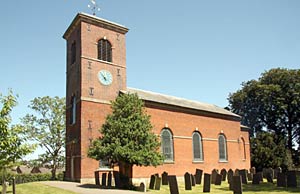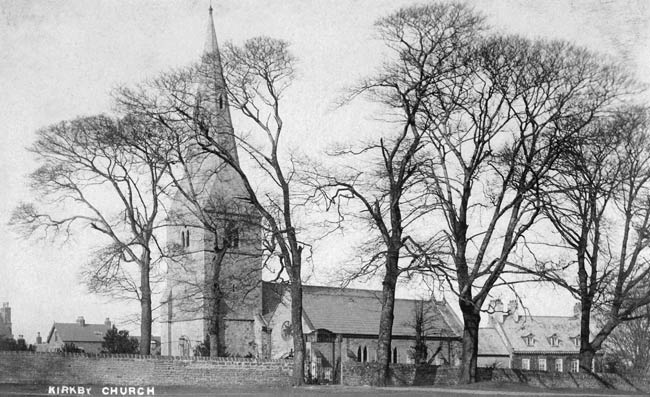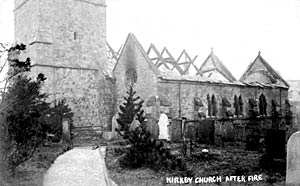< Previous | Contents | Next >

Kinoulton church in 2013.
© Copyright Richard Croft and licensed for reuse under this Creative Commons Licence
KINOULTON. Its claim to remembrance is the glorious prospect from its hill of the great Vale of Belvoir, with the castle on the horizon. The Grantham Canal goes under the road to wander through the fields, and opposite the forge is the plain brick church, built in 1793 after the old one near the Fosse Way was pulled down.
A Piece of old Sherwood Forest
KIRKBY-IN-ASHFIELD. Coal has changed the face of this countryside where three rivers come to life (the Erewash, the Leen, and the Maun,) but the loss of its beauty does not blind us to its old story. It came into Domesday Book, and may have had a Roman settlement. The name lives in a group of places today— Kirkby-in-Ashfield, Kirkby Woodhouse, and East Kirkby, the newcomer which has outstripped the others in size.
Its own folk still speak of East Kirkby as Kirkby Folly. In 1803 a man named Brown bought a field at the four cross-roads and began to build an inn, though there were only three cottages near. The inn was not completed, and was long spoken of as Brown's Folly, but Brown was only a little too soon. Mining and hosiery were soon to halt here in their stride, and the community which began to grow up round the cross-roads is the populous East Kirkby of today, with a pleasing 20th century church of brick and stone in the long street with a vista of two great slag heaps looking like toy mountains.
Kirkby Woodhouse straggles along to an old Baptist chapel built in 1754 and enlarged after a hundred years, its gabled porch projecting into a tiny old graveyard with an array of upright stones.
When the Stotevilles built their Norman castle on Kirkby-in-Ashfield's hilltop the site had Sherwood Forest for a background and a fine view over the Erewash Valley. The old earthworks are still here, near the church, and facing the church is the stone-walled village pound, and what is left of the stone manor house with twin gables, built 300 years ago and now divided into three dwellings.

St Wilfrid's church and rectory in Kirkby in Ashfield before the devastating fire of January 1907.

Kirkby church after the arson attack in January 1907.
The church was rebuilt after a fire in our own century; as the people watched its flames soaring to the sky they could see Annesley's new church still smouldering from a fire of the night before. Some of the masonry of old Kirkby Church survives in the new one, and in the floor of the porch are old coffin lids engraved with crosses. The new church has a round north arcade and a pointed south arcade in the style of those destroyed. It is notable for a statue of St Wilfrid in a niche on the porch, and rich carving on the hoods, the capitals and the corbels; for the beautiful oak stalls and pews, the handsome screen, and the organ case; and for windows glowing with colour.
The old market is no longer held, but a fragment of the tapering shaft of the old cross still stands on its old steps by the wayside in this oldest part of Kirkby, its distinguishing name of Ashfield reminding us that here was a clearing in the ancient Sherwood Forest, with ash trees abounding.
